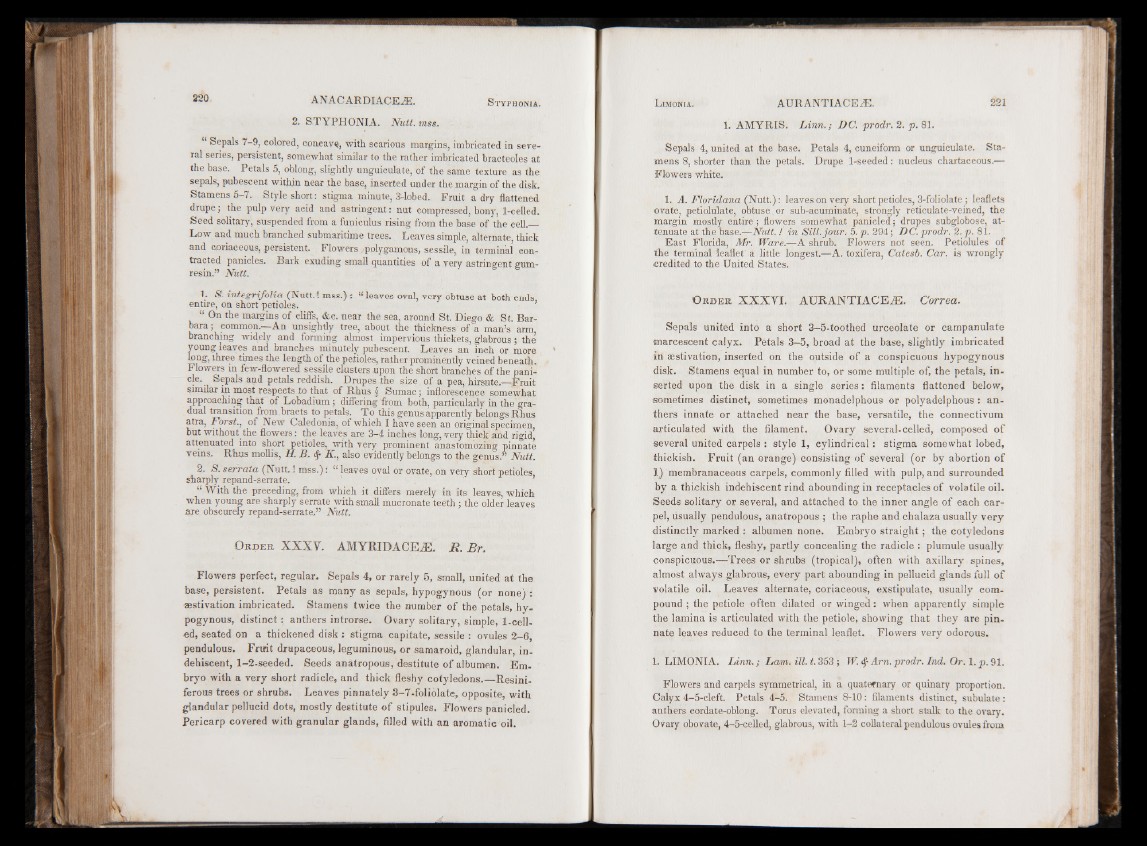
ANACARDIACEJS.
2. STYPHONIA. Nutt. mss.
“ Sepals 7-9, colored, concave, with scarious margins, imbricated in several
series, persistent, somewhat similar to the rather imbricated bracteoles at
the base. Petals 5, oblong, slightly unguiculate, of the same texture as the
sepals, pubescent within near the base, inserted under the margin of the disk.
Stamens 5—7. Style short; stigma minute, 3-lobed. Fruit a dry flattened
drupe; the pulp very acid and astringent; nut compressed, bony, 1-celled.
Seed solitary, suspended from a funiculus rising from the base of the cell.—
Low and much branched submaritime trees. Leaves simple, alternate, thick
and coriaceous, persistent. Flowers ..polygamous, sessile, in terminal contracted
panicles. Bark exuding small quantities of a very astringent gum-
resin.” Nutt.
L S. integrifolia (Nutt.! mss.); “ leaves oval, very obtuse at both ends,
entire, on short petioles.
“ On the margins of cliffs, &c. near the sea, around St. Diego & St. Barbara;
eommon.—An unsightly tree, about the thickness of a man’s arm,
branching widely and forming almost impervious thickets, glabrous; the
young leaves and branches minutely pubescent. Leaves an inch or more
long, three times the length of the petioles, rather prominently veined beneath.
Flowers in few-flowered sessile clusters upon the short branches o f the panicle.
Sepals and petals reddish. Drupes the size of a pea, hirsute,—Fruit
similar in most respects to that of Rhus § Sumac; inflorescence somewhat
approaching that of Lobadium; differing from both, particularly in the gradual
transition from bracts to petals. To this genus apparently belongs Rhus
atra, Forst., of New Caledonia, of which I have seen an original specimen,
but without the flowers; the leaves are 3-4 inches long, very thick and rigid,
attenuated into short petioles, with very prominent anastom’ozing pinnate
veins. Rhus mollis, H. B. K., also evidently belongs to the genus.” Nutt.
2. S. serrata (Nutt.! mss.) i “ leaves oval or ovate, on very short petioles,
sharply repand-serrate.
“ With the preceding, from which it differs merely in its leaves, which
when young are sharply serrate with small mucronate teeth; the older leaves
are obscurely repand-serrate,” Nutt.
O r d e r XXXY. AMYRIDACEiE. R. Br.
Flowers perfect, regular. Sepals 4, or rarely 5, small, united at the
base, persistent. Petals as many as sepals, hypogynous (or none) :
aestivation imbricated. Stamens twice the number o f the petals, hypogynous,
distinct: anthers introrse. Ovary solitary, simple, 1-eell-
ed, seated on a thickened disk ; stigma capitate, sessile : ovules 2- 6,
pendulous. Fruit drupaceous, leguminous, or samaroid, glandular, in-
dehiscent, 1- 2 -seeded. Seeds anatropous, destitute o f albumen. Em.
bryo with a very short radicle, and thick fleshy cotyledons,—Resini-
ferous trees or shrubs. Leaves pinnately 3 -7-foliolate, opposite, with
glandular pellucid dots, mostly destitute o f stipules. Flowers panicled.
Pericarp covered with granular glands, filled with an aromatic oil.
1. AMYRIS. L in n .; DC. prodr. 2. p. 81.
Sepals 4, united at the base. Petals 4, cuneiform or unguiculate. Stamens
8, shorter than the petals. Drupe 1-seeded: nucleus chartaceous.—
Flowers white.
1. A. Floridana (Nutt.): leaves on very short petioles, 3-foliolate ; leaflets
ovate, petiolulate, obtuse.or sub-acuminate, strongly reticulate-veined, the
margin mostly entire; flowers somewhat panicled; drupes subglobose, attenuate
at the base.—Nutt. ! in Sill. jour. 5. p. 294; DC.prodr. 2. p. 81.
East Florida, Mr. Ware.—A shrub. Flowers not seen. Petiolules of
the terminal leaflet a little longest.—A. toxifera, Catesb. Car. is wrongly
credited to the United States.
O r d e r XXXYI. AURANTIACEiE. Correa.
Sepals united into a short 3-5-toothed urceolate or campanulate
marcescent calyx. Petals 3 -5 , broad at the base, slightly imbricated
in aestivation, inserted on the outside o f a conspicuous hypogynous
disk. Stamens equal in number to, or some multiple of, the petals, in serted
upon the disk in a single se r ie s: filaments flattened below,
sometimes distinct, sometimes monadelphous or polyadelphous : anthers
innate or attached near the base, versatile, the connectivum
articulated with the filament. Ovary several-celled, composed o f
several united carpels : style 1, cylindrical : stigma somewhat lobed,
thickish. Fruit (an orange) consisting o f several (or by abortion o f
1) membranaceous carpels, commonly filled with pulp, and surrounded
by a thickish indehiscent rind abounding in receptacles o f volatile oil.
Seeds solitary or several, and attached to the inner angle o f each carpel,
usually pendulous, anatropous ; the raphe and chalaza usually very
distinctly marked : albumen none. Embryo stra igh t; the cotyledons
large and thick, fleshy, partly concealing the rad icle: plumule usually
conspicuous.—Trees or shrubs (tropical), often with axillary spines,
almost always glabrous, every part abounding in pellucid glands full o f
volatile oil. Leaves alternate, coriaceous, exstipulate, usually compound
; the petiole often dilated or winged: when apparently simple
the lamina is articulated with the petiole, showing that they are pinnate
leaves reduced to the terminal leaflet. Flowers very odorous.
1. LIMONIA. Lin n .; Lam. ill. t. 353; W. <f- Am. prodr. Ind. Or. 1. p. 91.
Flowers and carpels symmetrical, in a quaternary or quinary proportion.
Calyx 4-5-cleft. Petals 4-5. Stamens 8-10: filaments distinct, subulate:
anthers cordate-oblong. Torus elevated, forming a short stalk to the ovary.
Ovary obovate, 4-5-celled, glabrous, with 1-2 collateral pendulous ovules from